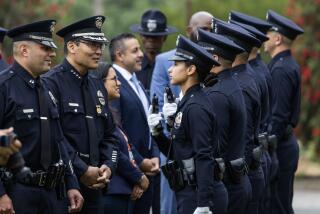SAN DIEGO COUNTY PERSPECTIVE : Putting More Cops on the Streets
San Diego Police Chief Bob Burgreen’s announced intention to transfer 70 to 100 officers to patrol duties from other assignments and the City Council’s tentative decision to hire 25 more officers and expand drug-abuse prevention efforts were welcome good news during these last few weeks of exceptional violence and grim statistics.
By the end of June, 80 criminal homicides had occurred this year in the city, 22 in June alone.
If that pace continues throughout 1991, a homicide record will be set for San Diego. July is not off to a hopeful start, with seven homicides in the first nine days.
True, the homicide rate is relatively low for the city’s size. San Diego is the nation’s sixth-largest city; its homicide rate is 10th. But that fact is little comfort for the families of Dennis Dalton, Vinh Nguyen and 9-year-old Laura Arroyo, just a few of last month’s victims.
Increasing the number of officers on patrol might not have saved their lives. But the Police Department found in a pilot project in City Heights that increasing police presence and officers’ participation in the community does reduce crime. It’s a preventive approach called community policing--endorsed just this week by the Christopher Commission in Los Angeles.
The San Diego Police Department wisely wants to foster and expand this approach. To do that, there must be more officers on the street to reduce beat size. Then it becomes feasible for officers to get involved.
Reassigning 100 officers is just a small step and doesn’t obviate the need for additional officers. San Diego’s ratio of 1.6 officers per 1,000 residents puts it ninth among the nation’s 10 largest cities. And the transfers won’t be without cuts in other services. But in a year of hemorrhaging state and federal budgets and rising homicides, it’s the right move.
More to Read
Sign up for Essential California
The most important California stories and recommendations in your inbox every morning.
You may occasionally receive promotional content from the Los Angeles Times.









